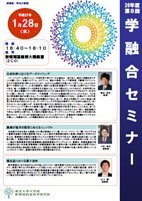AY2014 8th Gakuyugo Seminar
- Date&Time:
- Jan 28, 2015 16:40 - 18:10
- Venue:
- Large Lecture Room (2C0), New Frontier Science Bldg.

Data Mining in Life Sciences
Professor Koji TsudaIn the era of the personal genome, the amount of data handled in the life sciences continues to increase, and it is not difficult to face difficulties in analysis. The genome, epigenome, gene expression, protein expression, metabolite profiles, etc. of each individual are now available at relatively low cost, and multi-omics analysis is becoming possible. A common misconception in the analysis of such large amounts of data is that the amount of computation required for analysis is proportional to the amount of data. While this is generally true when analyzing a single type of data, the situation is much worse in the life sciences, where the main task is to perform integrated analysis to clarify the relationships among different types of data. For example, to reveal the association between 1,000,000 SNPs, 10,000 expression levels, and 10,000 CNVs would require 100 trillion calculations of evaluation values. It is not the increase of data itself that is the problem, but the combinatorial explosion caused by diverse data that is the most serious problem. Therefore, there is a need for a method that can rapidly discover combinatorial effects from data. Although there have been many attempts to apply data mining methods to biological data, they have not been widely adopted in life science papers. The reason for this is the inability to prove the statistical significance of the results obtained from data mining. Many journals require key results to be statistically significant, especially in the field of epidemiology where validation experiments are not possible. Data mining involves selecting hypotheses that fit the data from a very large number of hypotheses, and it is difficult to overcome the problem of multiple testing. In this presentation, I will describe a method to solve this problem.

Impacts of the Kuroshio Current on Marine Ecosystems
Associate Professor Yukio Komatsu
The Kuroshio Current, which flows off the southern coast of Honshu, and its surrounding waters are major spawning grounds for important floating fish species such as sardines, saury, horse mackerel, mackerel, and bluefin tuna. In order to properly manage and sustainably utilize these marine living resources, it is essential to elucidate the mechanisms of ecosystem change in the Kuroshio region, but this has yet to be fully elucidated due to its high velocity, high variability, and relatively small scale of the phenomena that govern the change. Recent high-resolution multi-objective field observations and ultra-high-resolution modeling have revealed that the Kuroshio is not just a boundary between the low nutrient and low productivity offshore (subtropical) region and the high nutrient and high productivity coastal region, but also contributes effectively to the production of the ocean in terms of nutrient supply through the effects of three-dimensional advection and eddy diffusion. It is now known that the three-dimensional advection and eddy diffusion effects effectively contribute to the production of nutrients. This presentation will introduce the forefront of Kuroshio ecosystem research.

Quantum Liquids at Cryogenic Temperatures
Associate Professor Minoru Yamashita
What would happen if we cooled down to near absolute zero? Since everything freezes at absolute zero, it seems that nothing interesting will happen. However, it is now known that mysterious physical phenomena such as superconductivity in metals and superfluidity in liquid helium appear at cryogenic temperatures. In this talk, I will introduce such phenomena peculiar to cryogenic temperatures, which are called quantum liquids, and introduce quantum spin liquids, which have recently attracted attention as new quantum liquids.
*The contents of this page were developed based on a machine translation.

